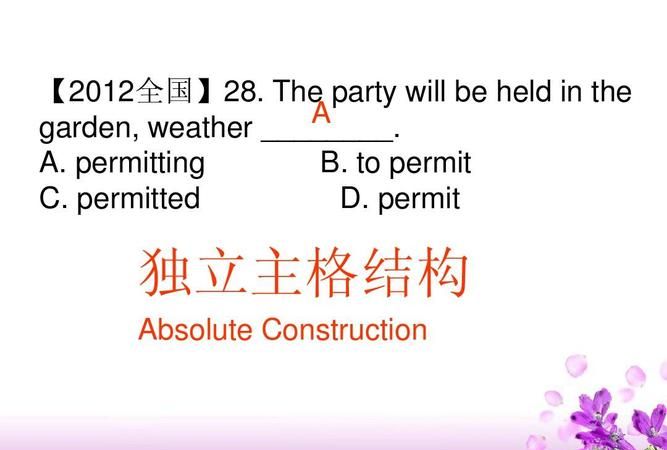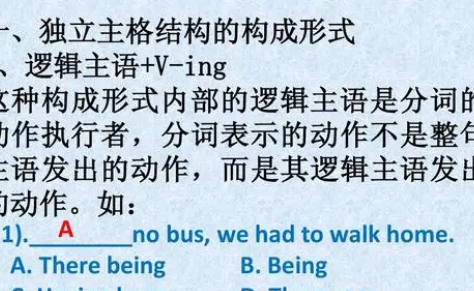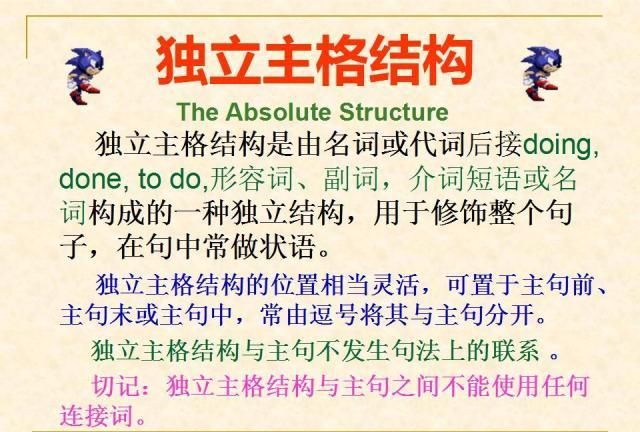本文目录
英语中的独立主格结构是什么意思
编辑本段独立主格结构(Independent Genitive)
独立主格结构有两部分组成,前一部份是名词或者代词,后一部分是非谓语动词或其他的一些词。前后两部分具有逻辑主谓关系。独立主格结构在句中做状语,多用于书面语。
独立主格结构本身不是句子,在句子中作状语,表示时间、原因、条件、伴随等。
常见的独立主格结构有如下几种:
1. 名词/主格代词+现在分词。名词/主格代词与现在分词之间主谓关系。如:
The girl staring at him (= As the girl stared at him), he didn”t know what to say. 姑娘两眼望着他,他不知道说什么好。
Time permitting (= If time permits), we will go for an outing tomorrow. 如果时间允许的话,我们明天去郊游。
2. 名词/主格代词+过去分词。名词/主格代词与过去分词之间的动宾关系。如:
The problems solved (= As the problems were solved), the quality has been improved. 随着问题的解决,质量已经提高了。
Her glasses broken (= Because her glasses were broken), she couldn”t see the words on the blackboard. 由于眼镜摔坏了,她看不见黑板上的字。
3. 名词/主格代词+不定式。名词/主格代词与不定式之间是主谓关系,且强调的是一次具体性的动作。如:
He is going to make a model plane, some old parts to help. 借助于一些旧零件,他要做一个飞机模型。
They said good-bye to each other, one to go home, the other to go to the bookstore. 他们道别后,一个回了家,一个去了书店。
4. 名词/主格代词+形容词。如:
An air accident happened to the plane, nobody alive. 那架飞机遭遇了空难,无一人生还。
So many people absent, the meeting had to be called off. 这么多人缺席,会议不得不取消。
5. 名词/主格代词+副词。如:
He put on his sweater wrong side out. 他把毛衣穿反了。
The meeting over, they all went home. 会议一结束,他们就都回家了。
6. 名词/主格代词+介词短语。如:
The boy goes to the classroom, book in hand. 那男孩手里拿着书去教室。
Mary was sitting near the fire, her back towards the door. 玛丽靠近火炉坐着,背对着门。
7. There being +名词(代词)如:
There being nothing else to do, we went home. 没有别的事可做,我们就回家了。
There being no further business, I declare the meeting closed. 没有再要讨论的事了,我宣布散会。
8. It being +名词(代词)如:
It being Christmas, the government offices were closed. 由于圣诞节的缘故,政府机关都休息。
It being a holiday, all the shops were shut. 由于今天是假日,所有商店都关门了。
独立主格结构的特点:
1)独立主格结构的逻辑主语与句子的主语不同,它独立存在。
2)名词或代词与后面的分词,形容词,副词,不定 式,介词等是主谓关系。
3)独立主格结构一般有逗号与主句分开。
举例:
The test finished, we began our holiday.
= When the test was finished, we began our holiday.
考试结束了,我们开始放假。
The president assassinated, the whole country was in deep sorrow.
= After the president was assassinated, the whole country was in deep sorrow.
总统被谋杀了,举国上下沉浸在悲哀之中。
Weather permitting, we are going to visit you tomorrow.
如果天气允许,我们明天去看你。
This done, we went home.
工作完成后,我们才回家。
The meeting gone over, everyone tired to go home earlier.
会议结束后,每个人都想早点回家。
He came into the room, his ears red with cold.
他回到了房子里,耳朵冻坏了。
He came out of the library, a large book under his arm.
他夹着本厚书,走出了图书馆
注:独立主格结构有时可在其前加上介词with。
如:Don’t sleep with the windows open. 别开着窗睡觉。
He was lying on the bed with all his clothes on. 他和衣躺在床上。
She came in with a book in her hand. 她手里拿着一本书走了进来。
He fell asleep with the lamp burning. 他没熄灯就睡着了。
I won’t be able to go on holiday with my mother being ill. 因为妈妈有病,我无法去度假。
He sat there with his eyes closed. 他闭目坐在那儿。
All the afternoon he worked with the door locked. 整个下午他都锁着门在房里工作。
I can’t go out with all these clothes to wash. 要洗这些衣服,我无法出去了。
使用独立主格五点注意:
1.独立主格与状语从句的转换当状语从句的主语与主句的主语不是指同一个对象时,可用独立主格结构取代状语从句,但不再保留连词。如:After class was over (=Class being over / Class over), the students soon left the classroom.下课后,学生很快离开了课室。
2. 不能省略being (having been)的情形在下列两种情况下,独立主格结构中的being(或having been)不能省略。
(1) 独立主格的逻辑主语是代词时。如:It being Sunday, we went to church.因为是星期天,我们去了做礼拜。
(2)在There being+名词的结构中。如:There being no bus, we had to go home on foot.因为没有公共汽车,所以我们不得不步行回家。
3. 通常不用物主代词或冠词在“名词(或代词)+介词短语”构成的独立主格结构中,一般不用形容词性物主代词和冠词。如: Miss Smith entered the classroom, book in hand.史密斯先生走进了课室,手里拿着一本书。比较with的复合结构。如:Miss Smith entered the classroom, with a book in his hand.
4. 独立主格结构没有所有格形式The chief-editor arriving, we began the meeting. 主编来主编来了,我们开始开会。(比较动名词复合结构。)
独立主格结构的用法
独立主格结构主要表示谓语动词发生的时间、原因、条件或伴随情况等,相当于一个状语从句或并列句。
1. 用作时间状语:The work done (=After the work had been done), we went home. 工作完成后,我们就回家了。
2. 用作条件状语:Weather permitting (=If weather permits), they will go on an outing to the beach tomorrow. 如果天气允许的话,他们将在明天组织一次海滨小游。
3. 用作原因状语:An important lecture to be given tomorrow (=As an important lecture will be given tomorrow), the professor has to stay up late into the night. 因为明天要发表一个重要的演讲,教授不得不熬夜到很晚。
4. 用作伴随状语:He was lying on the grass, his hands crossed under his head (=and his hands were crossed under his head).他躺在草地上,两手交叉枕在脑后。
5.表示补充说明:We redoubled our efforts, each man working like two. 我们加倍努力,一个人干两个人的活。
*注:独立主格结构表示时间、条件或原因时,相当于一个状语从句,一般放在句首,表示原因时还可放在句末;表伴随状况或补充说明时,相当于一个并列句,通常放于句末。
独立主格结构妙题赏析
请看下面一道题:
Not far from the school there was a garden, _________ owner seated in it playing chess with his little grandson every afternoon.
A. its B. whose C. which D. that
【分析】此题很容易误选B,许多同学会认为句中逗号后是一个非限制性的定语从句,whose 在定语从句中用作定语修饰其后的名词 owner。此分析从表面上看,似乎天衣无缝,但实质上是错的,原因是空格后根本不是一个句子,因为没有谓语。尽管句中有两个动词,但它们都是非谓语动词。也许有的同学认为,其中的 seated 可视为谓语动词,但是注意,seat 用作动词时,它总是及物的,其后要么接宾语,要么它就用于被动语态,所以若在 seated 前加上助动词 is,则可以选择B(当然若将 seated 改为sitting,也应选择B)。所以此题最佳答案选A。
请再看一个类似的例子:
(1) He wrote a lot of novels, many of _________ translated into foreign languages.
A. it B. them C. this D. that
(2) He wrote a lot of novels, many of _________ were translated into foreign languages.A. it B. them C. which D. that
第(1)应选B,而不能选C,是因为句中的 translated 是过去分词(非谓语动词),若选C,则该从句无谓语;第(2)应选C,因为句中有谓语 were translatedC。
再请看下面一例:
(3) He wrote a lot of novels, and many of _________ were translated into foreign languages.
A. it B. them C. which D. that
【分析】此题与上面的第(2)题不同,两句间多了一个并列连词and,说明这是一个并列句,故应选B,则不能选C。
请做做以下三题(答案均为B):
(1) There I met several people, two of _________ being foreigners.
A. which B. them C. whom D. that
(2) There I met several people, two of _________ were foreigners.
A. which B. whom C. who D. that
(3) There I met several people, and two of _________ were foreigners.
A. which B. them C. whom D. that

英语独立主格结构
英语独立主格结构
独立主格结构(Absolute Construction)由两部分组成,前一部分是名词或者代词,后一部分是非谓语动词(不定式、现在分词、过去分词)或形容词、副词、名词或介词短语。前后两部分具有逻辑主谓关系。
在英语中,动词按作用和功能主要分为两大类,一类是谓语动词,另一类是非谓语动词。独立主格结构在句中作状语,多用于书面语。独立主格结构本身不是句子,在句子中作状语,表时间、原因、条件、伴随、目的及状态等。

详细概述
非谓语动词作状语,其逻辑主语须与主句主语保持一致。若不一致,非谓语动词形式须另带主语,从而构成复合结构的形式作状语。这种结构称为“独立结构”。其中,非谓语动词主动用现在分词,被动用过去分词。
功能
独立主格结构主要用于描绘性文字中,其作用相当于一个状语从句,常用来表示时间、原因、条件、行为方式或伴随情况等。例如:
表示时间
The meeting being over, all of us went home. 开完会后我们都回家了。
Her work done, she sat down for a cup of tea. 她干完了活,坐下来喝茶。
表示条件
The condition being favourable, he may succeed. 如果条件有利,他或许能成功。
表示原因
There being no taxis, we had to walk. 没有出租车,我们只好步行。
He wrapped her up with great care,the night being dark and frosty. 夜又黑又冷,所以他把她裹得严严实实的。
In the middle of February,the weather being favorable for work,the workers began to repair and secure the dam of the river.二月中旬,天气有利于工作,工人们开始修缮河坝。
表示伴随情况
Almost all metals are good conductors,silver being the best of all. 几乎所有的金属都是良导体,而银则是最好的导体。(=Almost all metals are good conductors, and silver is the best of all.)
英语的独立组格结构是什么意思
一、什么是独立主格结构
所谓独立主格结构就是一个与句子相对独立的带有逻辑主语的结构。
由于这个逻辑主语与它所支配的行为状态表达的是辅助主要句子的另一层独立的意思,加之要用代词和名词的主格形式(现代英语中名词的主格与宾格是一致的)表示,因此这种逻辑主语就称作独立主格。逻辑主语加上它所支配的行为状态就构成了一种语法结构,这种语法结构称为独立主格结构。如下列例句中的括号部分:
* (Everyone being ready), the teacher began his class. 每个人都准备好后,老师开始上课。
独立主格(即逻辑主语):Everyone
独立主格的行为状态:being ready
起到的辅助作用:表示 the teacher began his class 发生的时间
* (It being National Day today),the streets are very crowded. 由于今天是国庆节,街上很拥挤。
独立主格:It
独立主格的行为状态:being National Day today
起到的辅助作用:表示the streets are very crowded 的原因
* The manager looks relaxed, (many things settled). 由于许多事情已经处理好了,经理看上去很轻松。
独立主格:many things
独立主格的行为状态:settled
起到的辅助作用:表示The manager looks relaxed 的原因
二、独立主格结构的构成
独立主格由两部分组成——
1、逻辑主语(即独立主格):由代词的主格或名词充当独立主格
2、叙述语:用来陈述逻辑主语的行为状态。
其中叙述语是独立主格的重点。
三、能够构成独立主格结构中叙述语的词语
1、现在分词(-ing 非谓语动词)
——用作时间状语,如:
The chairman began the meeting , everyone being seated. 每个人坐好后,主席开始开会。(相当于一个时间状语从句after everyone was seated)
——用作原因状语,如:
Many eyes watching him, he felt a bit nervous. 许多眼睛看着他,他感到有点儿紧张。(相当于一个原因状语从句As many eyes were watching him)
——用作条件状语,如:
Time permitting, we will have a picnic next week. 时间允许的话,我们下星期将进行一次野炊。(相当于一个条件状语从句If time permits)
My health allowing, I will work far into the night. 我的健康许可的话,我愿工作到深夜。(相当于一个条件状语从句If my health allows)
——用作伴随方式的状语
The boy lay on the grass, his eyes looking at the sky. 男孩躺在草地上,眼睛看着天空。(相当于一个并列分句and his eyes were looking at the sky)
2、过去分词(-ed非谓语动词)
* The book written in simple English, English beginners were able to read it. 该书是用简单英语写的,英语初学者也能看懂(原因状语 , = As the book was written in simple English,English beginners were able to read i)
* He was listening attentively in class, his eyes fixed on the blackboard. 他上课专心听讲,眼睛紧盯着黑板。(方式状语,= He was listening attentively in class, and his eyes were fixed on the blackboard. )
* The task completed, he had two months' leave. 任务完成以后,他休了两个月的假(时间状语。=When the task had been completed,he had two months' leave. )
3、不定式(to do)
* I send you 100 dollars today, the rest to follow in a year. 现寄给你100美元,其余部分将在一年以后再寄。(方式状语,= I send you 100 dollars today, and the rest is to follow in a year.)
* The manager looks worried,many things to be settled. 经理看上去很着急, 有这么多的事情要处理。(原因状语,= The manager looks worried because many things will be settled):.
4、形容词短语
* He turned to me, his eyes sleepy. 他睡眼惺忪地转向我。(= He turned to me, and his eyes were sleepy.)
* He stood there, his mouth wide open. 他站在那里,嘴张得大大的。(= He stood there, and his mouth was wide open.)
5、小品副词(指既可以用作介词又可以用作副词的词) .
* School over, we all went home. 放学了,我们都回家了。(= School was over, and we all went home.)
* He sat at his desk, his shoes off. 他坐在课桌旁,没穿鞋子。( = He sat at his desk and his shoes were off.)
6、介词短语
* He is standing in front of the blackboard, his back towards us. 他站在黑板面前,背对着我们。( = He was standing in front of the blackboard, and his back was towards us.)
* The new teacher came in, a smile on her face. 新老师面带微笑走了进来。( = The new teacher came in and she had a smile on her face.)
* The teacher came into the classroom,a rule in his hand. 老师走进教室,手里拿着一把直尺。( = The teacher came in and a ruler was in his hand.)
注:表示伴随方式的独立主格结构还可以用“with + 逻辑主语 + 叙述语”表示。
请参阅我的博文:
***/%D5%C5%B4%EF%C8%CB/blog/item/f201c2c7c2f9d5049c163d41.html

英语中的悬挂结构是什么意思
独立结构是带有自己逻辑主语的结构,又称独立主格结构。作为句子的一个语言单位,其行文简单明了,功能多样。
Ø
独立结构的形式
I.
名词(或主格结构)+动词的非谓语动词形式
Here
are
the
first
two
volumes,
the
third
one
to
come
out
next
week.
The
plan
having
been
made,
what
is
important
is
to
put
it
into
practice.
The
duty
completed,
he
had
three
months’
leave.
II.
名词(或主格代词)+形容词
He
entered
the
room,
his
nose
red
with
cold.
She
looked
at
him
expectantly,
her
eyes
full
of
excitement
and
curiosity.
III.
名词(或主格代词)+介词短语
I
stood
at
his
left,
my
finger
on
the
button,
waiting
for
the
order.
The
teacher
entered
the
classroom,
chalk
in
one
hand,
(a)
textbook
in
the
other.
IV.
名词(或主格代词)+副词
Class
over,
all
the
students
went
out
from
the
classroom.
He
put
on
his
socks,
wrong
side
out.
V.
名词(或主格代词)+名词
His
first
shot
failed,
he
fired
again.
She
sat
alone
in
the
room,
her
only
company
a
dying
fire.
注意:以上独立结构都可以看成是带being的分词复合结构的省略形式。加入being就变成了分词的复合结构。如:
Here
are
the
first
two
volumes,
the
third
one
(being)
to
come
out
next
week.
He
entered
the
room,
his
nose
(being)
red
with
cold.
I
stood
at
his
left,
my
finger
(being)
on
the
button,
waiting
for
the
order.
VI.
介词with或without引导的独立结构
这种独立结构的一般构成为:with/without+名/代词+(分词、形容词、副词、不定式、介词短语),如:
With
the
old
man
leading,
the
two
started
towards
the
mountains.
She
felt
nervous,
with
all
eyes
fixed
on
her.
Never
sleep
with
the
window
open
in
the
winter.
With
John
away,
we’ve
got
more
room.
With
five
minutes
to
go
before
the
last
train
left,
we
arrived
at
the
station.
His
wife
came
down
the
stairs,
with
her
two-year-old
son
in
her
arms.
VII.
“There
being
+名词”
结构
There
being
no
money
left,
we
have
to
change
our
plan.
There
being
no
spare
parts,
the
equipment
could
not
be
repaired
at
once.
Ø
独立结构的句法功能
独立结构在句中多作状语,表示时间、条件、原因、方式、伴随或补充说明,偶尔也作定语或主语(如最后两例句),如:
The
bell
ringing,
all
the
pupils
went
into
the
classroom.
Weather
permitting,the
football
match
will
be
played
next
Sunday.
The
question
being
rather
difficult,
we
must
take
time
to
consider
it
carefully.
The
brave
man
fought
the
man-eating
tiger,
a
stick
his
only
weapon.
How
can
I
work
with
you
making
all
that
noise?
The
war
was
over,
without
a
shot
being
fired.
A
little
boy
with
two
of
his
front
teeth
missing
ran
into
the
room.
Jenny
in
trouble
was
the
reason
for
my
rushing
there.

以上就是关于英语独立结构是什么,英语中的独立主格结构是什么意思的全部内容,以及英语独立结构是什么 的相关内容,希望能够帮到您。
